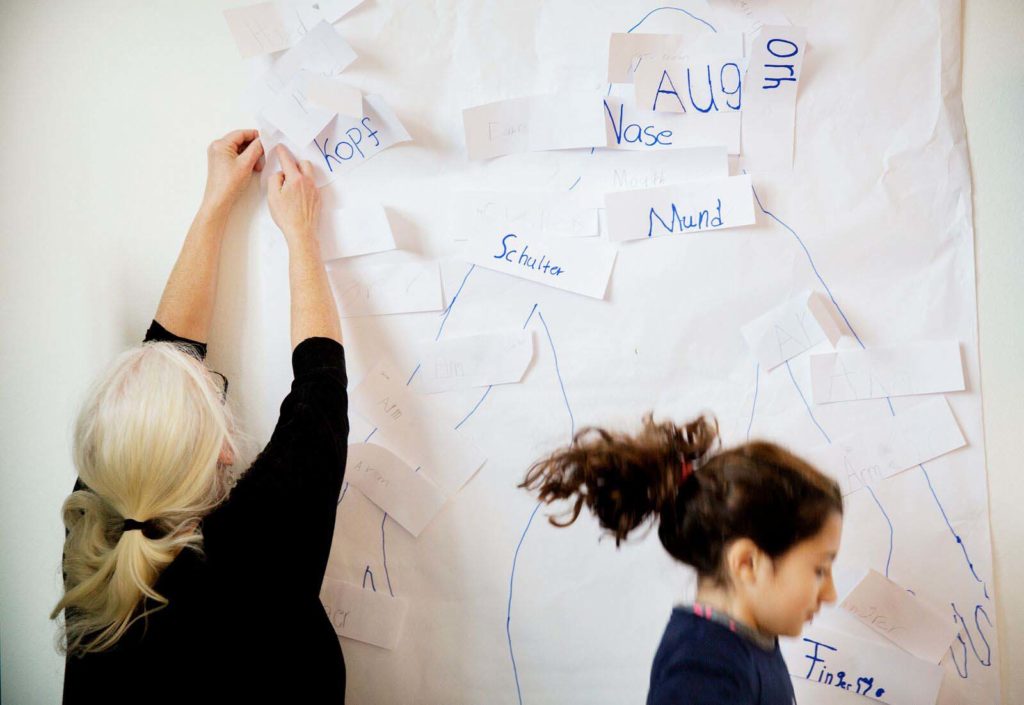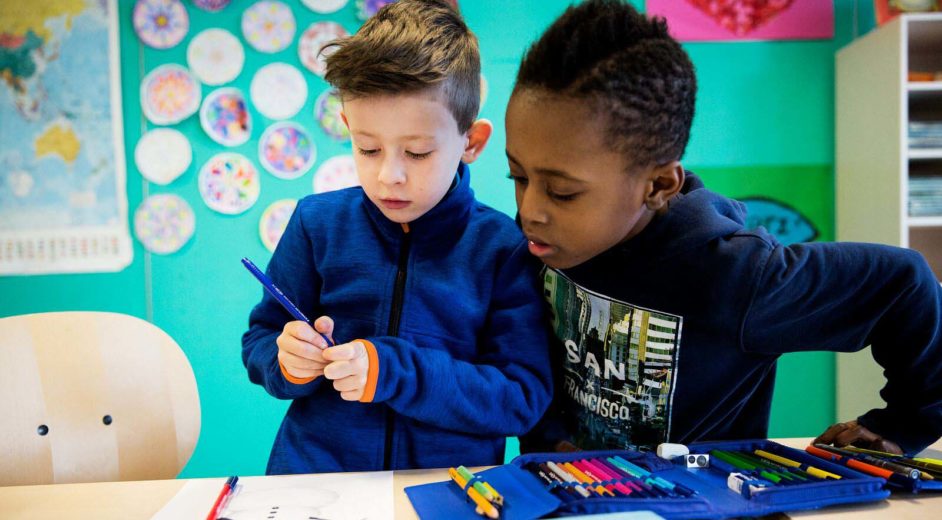Two, Three, or Four Languages – Your Brain Can Do It
In many countries, pupils learn a first and second foreign language at an increasingly younger age. Research shows early foreign language learning in and of itself does not lead to more nor better learning. It namely requires well-founded didactic competences to teach the youngest schoolchildren, and it is therefore important to invest in further education for teachers. A Nordplus project has now shown that it is possible to build a bridge between Nordic public schools, teacher education, further education for teachers, and university research.
By Joan Rask
The tendency is the same in all Nordic and Baltic countries. Children as young as 4-6 years of age receive foreign language teaching. That requires new competences of the teachers because the dialogue and the didactic possibilities are completely different than with older children.
Most teachers receive no or barely any further education in stimulating early language development, and the required knowledge and tools are lacking in several Nordic countries. A couple of years ago, Petra Daryai-Hansen, lecturer at the University of Copenhagen and docent at University College Copenhagen, had a great wish to develop the work with early foreign language learning in a Nordic context where didactics can, to a greater extent, be brought into play – both for the children who learn only one foreign language and for those who learn multiple foreign languages. She admits that it has worked out brilliantly. The final conference on the two-year project has just been held and the feedback from participants speaks for itself.
“It took me by surprise that people were so excited and almost euphoric and called the project ‘exemplary’. I hadn’t seen it coming,” says the lecturer.
In Denmark, the A.P. Møller Foundation has donated to the work with early foreign language learning. When Petra Daryai-Hansen applied for funds, she referenced the experiences and the colleagues from Sweden and Norway where more research in the area had been done. That changed when the Consortium for Language and Didactics at the University of Copenhagen and University College Copenhagen later received the donation from the A.P. Møller Foundation because now the Danish experts could suddenly bring their resources and knowledge into play. At the time, Petra Daryai-Hansen saw the opportunity for applying the project in a common Nordic-Baltic context.
“When looking for partners, we looked for public schools, universities, and teacher education institutes with prior experience in working with early foreign language learning and plurilingual didactics. Had we not found others who were already experts, I don’t think we would have succeeded,” she says.
My language is not better than yours
One of the experts Petra Daryai-Hansen knew was Beate Lindemann, professor at the Institute for Language and Culture at the University of Tromsø. Here she works with the German language, teacher education, and further education for teachers.
“We are on our own in the Nordic and Baltic countries even though it’s the same solutions and tools we’re looking for. But when more minds think alike, we become a team and we have been a team for two years now, and we have therefore found a way,” says Beate Lindemann.

She specifies that the individual teacher must still work with the pupils in practice, but because the theoretical issues are so similar, it is possible to learn from one another and look to both research and practice experience from across the Nordic countries.
“The special thing is that we link foreign language learning to plurilingual didactics. In that way, we build a bridge between all languages pupils receive teaching in (that is, Swedish, Danish, Norwegian) and the potential other languages which are also represented in the classroom,” she explains.
Her part of the work has mainly been focused on developing further education teaching materials for language teachers. She emphasises the importance of the existing providers of further education in the municipalities and so on can build on and develop the teaching materials to make it fit their individual contexts.
She explains that it is not appropriate to talk about grammar, genitive and accusative cases which older children have been struggling with for decades.
“The good thing is that younger children are especially motivated, yet the teaching should be different. You cannot have them sit primarily alone with translations of texts,” she says.
10 minutes is better than an hour
Miriam Härgestam and Sofi Rimmevik have the same experience. They both teach children aged 7-9 at Forsdalaskolan in Lycksele in the middle of Sweden. Here they have been testing the methods developed as part of the Nordplus project “Developing Early Foreign Language Learning and Teaching in the Nordic/Baltic Context”.
“The first question was how long a lesson is supposed to be when you are 7 years old? We ended up deciding on 10 minutes every day rather than an hour a week. It works better with the children,” says Sofi Rimmevik.
At Forsdalaskolan, there are on average three children speaking at least two languages in each class. It is an extra dimension that has become increasingly significant for the foreign language teachers, as the youngest children also have to learn foreign languages such as English.
“Sometimes we have told the pupils they were being tested and other times we have just observed them. The youngest children are always excited about learning new languages. They are not afraid of making mistakes and play around a lot more,” says Miriam Härgerstam.
The two women experience the daily joys and frustrations associated with being in a classroom.
“The children who cannot speak their first language adequately and simultaneously struggle with Swedish can become confused if they have to learn English too, and therefore it’s extremely important that the parents continue using their first language at home,” says Miriam Härgerstam.
Beate Lindemann thinks very positively about the increased focus on teaching methods.
“It has provided me and many others with a different opinion on how we teach languages. We can namely make it more exciting and more inspiring,” she says.
And – she eagerly adds, almost interrupting herself – that an additional benefit is that when children in 5th grade become better at a language, there is a noticeable positive effect on their later performance in 9th grade.
“There’s a paradigm shift coming in language education –children become truly plurilingual, a lot of children are already bilingual. There’s no shame in that! It’s an incredible resource and the fact that, for example, some have insight into Arabic is just fantastic – the teachers need to utilize it and not problematize it,” says Beate Lindemann.
Your brain can do it
These observations are in line with those of Petra Daryai-Hansen, the lecturer from Copenhagen who also speaks German, French, English, and Danish – and a bit of Farsi and Italian, and besides understands Norwegian and Swedish.
“When you know multiple languages, a lot becomes more transparent when learning a new language, and the more languages you know, the more skills you can draw upon,” she says.
She draws attention to the myth that children’s brains can become “overloaded”.
“The prerequisite for success is of course that the teachers work didactically with the pupils’ plurilingualism. And it’s good that all pupils become aware of languages – it gives them respect for other people and different cultures. The main point is that all languages are equal – because there exists no language that is better than other languages,” says Petra Daryai-Hansen.
The two teachers are still implementing the new methods at Forsdalaskolan where many children speak an additional language besides their Nordic language.
“It has been as if we have built bridge between schools and universities. Normally, you attend further education and listen to the researchers, but here we have all joined together and developed and tested in cooperation. It has been really good,” says Sofi Rimmevik.
The two women look at each other, nod and become quiet for a little while.
“We hope we can help… but we dream about an increased number of pedagogues so we could split the children into smaller groups. It can be very difficult with the larger class sizes and many different languages,” says Sofi Rimmevik.
* Picture at the top and caption:
English teaching in first grade. Part of the project "Previous language start". Photographer: Jacob Nielsen
» Read the article in a Nordic language: To, tre eller fire sprog - din hjerne kan godt
Coordinating institution
- Københavns universitet
Partner institutions
- University of Umeå
- The Arctic university of Norway
- University College of Southeast Norway
- Vilnius University
- Københavns Professionshøjskole
- Randersgades Skole
- Vilnius Sietuva Progymnasium
- Østfold University College
- Forsdalaskolan
- Kjelsaas School
- Korsvoll School
Project:
- Nordplus Horizontal
